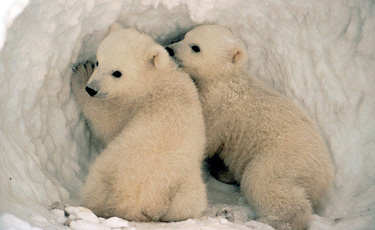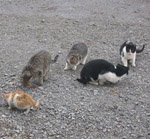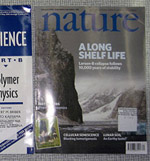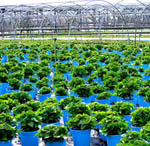Sea ice decline linked with reduced polar bear size and reproduction
 Polar bear cubs (Ursus maritimus) chilling out. Credit, USFWS.Polar bears are often put forward as a poster animal for climate change. Concerns abound over the potential impacts decreased sea ice may have on the charismatic icons of the arctic.
Polar bear cubs (Ursus maritimus) chilling out. Credit, USFWS.Polar bears are often put forward as a poster animal for climate change. Concerns abound over the potential impacts decreased sea ice may have on the charismatic icons of the arctic.
Now a new study from the southern Beaufort Sea along the north Alaska coast provides empirical support for those concerns by indicating that sea ice decline is associated with reduced body size and cub recruitment - i.e. the number of polar bear cubs that make it to adulthood.
In a paper published in Ecological Applications, Karyn Rode and fellow researchers from the U.S. Fish and Wildlife Service and U.S. Geological Survey test a suite of questions designed to examine the extent to which polar bears are affected by sea ice declines in the southern Beaufort Sea.
Sea ice in this area experienced an overall “chronic decline” throughout the study time frame between 1982 and 2006, though coverage varied widely annually, with some years showing increases.
The difficulty facing the researchers was overcoming the age-old ‘correlation is not causation’ bugbear. Observing declines in indices of polar bear condition at the same time as sea ice declines is not sufficient evidence for supporting a hypothesis that the two are related.
The key lies in the influence of nutrition on body size. A very well-documented link exists, particularly for bears, between food availability and body mass and skeletal size, even for fully grown individuals. And for polar bears, sea ice is essential for food.
The bears’ main diet, ringed and bearded seals in the southern Beaufort, can only be accessed from sea ice. If insufficient sea ice exists, bears don’t eat enough, their condition deteriorates and this affects birth rate and cub survival.
This study found that polar bear population declined both in total numbers and in the size of individual bears.
Although study-wide trends in mass, skull width and body condition were complex, results were generally consistent: measurements declined with the sea ice.
Similarly overall reproductive output declined between 1982 and 2006 both in terms of litter mass and number of cubs. However, in springs when sea ice increased, the number of yearlings per female also increased.
In an apparent contradiction, body mass of females with yearlings actually increased over time. However, the authors suggest that this indicates that only females in “the best condition are successfully rearing cubs to this stage.” The implication is that cubs of females in marginal condition do not survive to become yearlings.
This relates to perhaps the most convincing argument. The greatest effects of reduced sea ice were on younger bears. The normally fast growth of juvenile bears was not so fast.
The authors interpret this as suggesting younger bears are at greater risk to the nutritional limitations of reduced ice. Perhaps the effects of sea ice declines are just now beginning to be revealed.
--by Ian Adams
Rode, K., Amstrup, S., & Regehr, E. (2010). Reduced body size and cub recruitment in polar bears associated with sea ice decline Ecological Applications, 20 (3), 768-782 DOI: 10.1890/08-1036.1




 Arctic
Arctic
Reader Comments